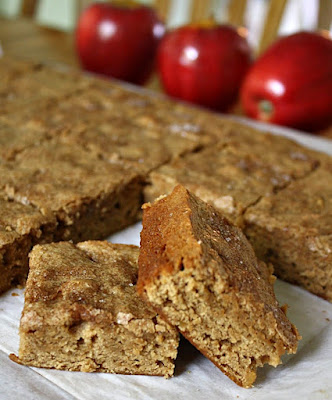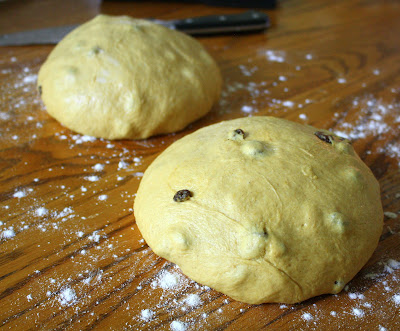Ahh, yes, cinnamon chips. They were one of those newish ingredients I was loathe to try when they first appeared in the grocery store a couple of years ago, because they just sounded too fake to me. I envisioned little waxy textured, synthetically-flavored dots of hardened goo. It wasn't hard to tamp down what was a very moderate curiosity to begin with. I passed them by in the market week after week. No backward glance. Something--I knew not what--would have to legitimize cinnamon chips before I would trade cold hard cash to procure them.
I had a sizable chunk of Callebaut white chocolate on hand, so I cut off a modest wedge, melted it slowly and carefully in the microwave, mixed in a scant teaspoon of ground cinnamon, spread the mixture thinly onto a piece of plastic wrap, sprinkled more cinnamon over that, laid another piece of plastic wrap over that, and slid it into the freezer for less than five minutes. Once rigid as a board, I broke the cinnamon-chips-to-be into a zillion tiny pieces, added them into my scone batter, and voila! Homemade cinnamon chips in homemade pumpkin scones. Sensational.
What, I ask you, is autumn without a nice warm batch of pumpkin scones cooling on the kitchen table? I dare not think.
About this recipe . . .
Adapted from a King Arthur recipe aptly titled Harvest Pumpkin Scones, I made only a couple of small changes to the formula. I used a little more pumpkin than called for, along with a smidgen of 1/2 and 1/2; my dough, otherwise, would have been extremely dry. I also reduced the amount of allspice by half. I used homemade cinnamon chips, and I reworded the recipe to reflect my actual steps.
Pumpkin Scones with Do-it-Yourself Cinnamon Chips
(For a printable version of this recipe, click here!)
Yield: 8 large scones.
No mixer needed for this recipe (yay!).
Ingredients for the homemade cinnamon chips:
3 oz. of good quality white chocolate, or white chocolate chips
1 teaspoon ground cinnamon
and
1/2 teaspoon ground cinnamon
Ingredients for the scone dough:
2 and 3/4 cups unbleached all-purpose flour
1/3 cup granulated sugar
1 tablespoon baking powder
3/4 teaspoon fine sea salt
3/4 teaspoon ground cinnamon
1/4 teaspoon ground ginger
1/4 teaspoon ground nutmeg (I use fresh grated, and buy the whole nutmeg at a Penzey's spice store.)
1/8 teaspoon allspice
1/2 cup (1 stick) cold butter, cut into 1/2 inch chunks
3/4 cup canned pumpkin
1 tablespoon 1/2 &1/2 (or use milk)
2 eggs, large
A few tablespoons coarse white sugar (aka sanding sugar) to sprinkle on the scones before baking
2 tablespoons of 1/2 &1/2 or milk
To make the cinnamon chips:
Melt the white chocolate slowly and carefully in your microwave, or melt it in a small bowl set over a pan of simmering water on the stove. If you do it on the stove, be sure no water at all gets into the bowl with the white chocolate. Stir the 1 teaspoon of cinnamon into the melted white chocolate thoroughly. Spread out a small sheet of plastic wrap on a flat surface. While the chocolate is still very warm, spread it out thinly on the plastic wrap using a spatula or bowl scraper. Sprinkle the 1/2 teaspoon of cinnamon over that. Cover it with another sheet of plastic wrap. Put it in the freezer for five minutes. Take it out when it's stiff as a board. Break it up into mini-chip-size pieces.
To make the scone dough:
Whisk together, in a large mixing bowl, the flour, granulated sugar, baking powder, salt, cinnamon, ginger, nutmeg, and allspice.
Using a pastry blender, a fork, or even your fingers, work the butter into the dry ingredients until crumbly. It's fine if some small lumps remain. Toss all of the homemade cinnamon chips in and stir to combine.
In another bowl, whisk together the eggs and canned pumpkin. Pour all of this into the bowl of dry ingredients and stir until it comes together into a solid dough.
Turn the dough out onto a lightly floured surface, and pat it into a ball.
Press the dough with your hands into a large circle, at least 10 inches in diameter and 3/4" thick. Using a sharp knife or a pastry wheel, cut the circle, pie-style, into 8 even triangles. Lay the triangles on a parchment covered baking sheet. I bake my scones so they're not sitting right next to each other, and they have a chance get golden brown all over; you may also choose to bake them about 1/2" apart from each other so they'll end up slightly attached and less crispy on the sides. Brush the tops of each one with half and half, and sprinkle generously with coarse/sanding sugar or regular granulated sugar (coarse sugar will be more sparkly, once baked).
Preheat your oven to 400 degrees. Now put the scones, still on the baking sheet, into the freezer for about 20 minutes. (This step is a recommendation from KAF, and I think it really does seem to add to the scones' oven spring. They puff up nicely.)
Bake the scones for at least 20 minutes. They are done when they're golden brown, and a toothpick inserted in the thickest part comes out completely clean. Serve them warm or cold. Best the first day, but still pretty good the second!
(If you'd like to comment on this post, or to read any existing comments, please click the purple COMMENTS below.)





























































